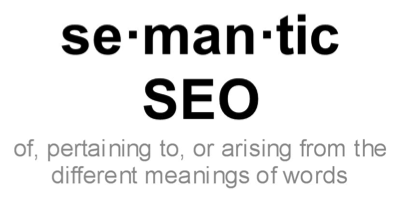 The New Year is the perfect time to try new things and see what works for your company, but there are a few things that you really have to try in 2014 if you want to keep up and be successful. Semantic SEO, a new kind of SEO strategy, is something that’s going to be crucial this year.
The New Year is the perfect time to try new things and see what works for your company, but there are a few things that you really have to try in 2014 if you want to keep up and be successful. Semantic SEO, a new kind of SEO strategy, is something that’s going to be crucial this year.
Based on the Google updates and changes made last year, it’s clear that Google is trying to move their algorithm toward analyzing sites based on other factors besides just keywords. As Google evolves, it’s important you understand how semantic SEO works so you don’t fall behind.
A Quick Recap: How Semantic SEO Works
For those who are unfamiliar, semantic SEO is about optimizing your content for related terms and connections that a searcher might make to that content. For example, using the word “car” in your content frequently or optimizing your page for that term isn’t going to be quite as important anymore. Now, terms like “automobile,” or even related topics such as “mechanics” or “car loans” will all be taken into account when it comes to rankings and should therefore be taken into account when writing and optimizing.
Of course, there is a little bit more to the idea of semantic SEO (along with what many call the “semantic web”) as well as tips to create a semantic strategy. Visit this article learn more about how it all works and this article to learn more about some tools that can help.
Why Semantic SEO Will be More Important in 2014 Than Ever
The idea of semantic SEO has been around for quite some time, but there were two different signals and hints we got from Google this past year that can lead us to believe it’s only becoming more important to understand:
- The Hummingbird Update: The Hummingbird update was all about revamping the algorithm to keep up with how people search today—more conversational and less keyword-based. It was the first update of its kind in over 10 years, so it made quite a stir in the SEO community. It shows that Google is ready to make serious changes in order to keep with how search is changing.
- Knowledge Graph. The Google Knowledge Graph shows up for certain subjects on the right hand side of a Google SERP. It shows relationships between different things across the web and helps to cut down on ambiguity. This past year, Google added more categories and filters to the Knowledge Graph. Focusing on semantics will help you focus on the related concepts to your content and articles, which will help you get more involved in this way of organizing the web.
Have you used semantic SEO in the past? Is there any other SEO method you think is going to be a necessity in 2014? Let us know your story and your thoughts in the comments below.
Photo Credit: copywritingservicespro.com
Amanda DiSilvestro gives small business and entrepreneurs SEO advice ranging from Google Analytics How-To’s to AdWords best practices. She works as a ghost writer and freelancer at amandadisilvestro.com and Coastal SEO Consulting, and works as the Marketing Manager for a Travel Company, Discover Corps, full-time. Visit her website to learn more!
One thought on “Don’t Forget about Semantic SEO in 2014”
Comments are closed.